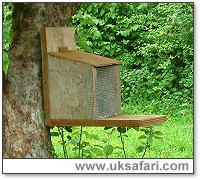
|

|
|
 Sent
to you Sent
to you
by e-mail
|
|
Simply
enter your details and hit the send button
more
info |
|


Click Here

Links
Advertise
Terms of Use
Contributors
About Us
Contact Us
|
 |
Go back
 | Bookmark
| Bookmark
 | Print Page
| Print Page  | E-Mail Us
| E-Mail Us 
Warning: Squirrels May Contain Large Quantities of Nuts
 Photo: G. Bradley
Photo: G. Bradley
|
|
UK
Safari Tip:
Subscribers can download this article as an illustrated factsheet from the
Members Area - click
here
|
|
It’s not that we don’t like them, it’s just the damage we’re not too
keen on. It was when we were repairing the bird feeders for around the
tenth time we decided something ought to be done to stop the grey squirrels
gnawing holes through them.
We’d been thinking about putting up a special squirrel feeder, so this seemed
a good time to give it a go. Rather than buy one we decided to make our own from
some old plywood. It was just like the ones in the catalogue. It had a special
platform on the front for the squirrels to stand on, and a lift up lid so they
could reach in and grab the nuts. We hung it on a tree, a good distance from the
bird feeders, filled it up and waited.
OLD HABITS DIE HARD
For a couple of days the squirrels took no notice of their new feeder.
Occasionally they would have a sniff round it on their way to and from the bird
feeders. They could obviously detect the faint aroma of ‘eau de peanuts’
inside, but the easy pickings in the bird feeders were clearly a less
complicated option.
After a few days we noticed one squirrel had found his way into the feeder. The
lid was up and he was having a good rummage around inside. He kept looking in
the box, then looking up, then looking back in the box again. It was like
someone with a winning Lotto ticket, who had to keep checking their numbers to
make sure it was true. We knew it was a success when he grabbed a nut and
scampered off. We figured it was just a matter of time before they were weaned
off the bird feeders.
NEW ARRIVALS
The next day we looked out of the windows to see half a dozen grey squirrels in
the garden. This was more than we'd seen in the garden before. There were some
on the bird feeders, some on the squirrel feeder, some scurrying around the lawn
doing squirrel type things. The arrival of extra squirrels was not something we'd anticipated.
We checked the squirrel feeder and it was empty. We thought this was quite a lot
of nuts to eat in one day, but we refilled it anyway.
Throughout the morning the squirrels kept visiting their feeder. They also continued to
empty and destroy the bird feeders. In the afternoon we checked the squirrel
feeder and it was empty again. Maybe this experiment needed a re-think.
If
you've ever watched squirrels in the wild you'll know what was going wrong. When
there's an abundance of acorns about they eat what they can, then bury the rest. That's exactly what
happens when you put a box full of peanuts in your garden for them. They eat
what they can, bury the rest, then come back and empty your bird feeders too.
The other side-effect of squirrel feeders is that the population
grows in proportion to the food supply. More peanuts = more squirrels. We now
have around a dozen squirrels, as two of the females have now had babies.
LESSONS LEARNT
If you're lucky enough to live in an area with red squirrels then putting up a squirrel feeder is a good idea.
There are special feeders available which will only allow red squirrels to use them, and prevent the
heavier greys from getting a meal. On the other hand, if you're thinking of putting up a squirrel feeder to
keep grey squirrels off your bird feeders - forget it.
The best way to keep your bird feeders strictly for the birds is to invest in some “squirrel-proof” bird
feeders. We purchased two of these feeders from the RSPB - one for seeds and one for peanuts. They’re
manufactured by “The Nuttery”, based in Pinner, Middx. They’re also available from many large garden
centres.
When we first put the feeders up our furry grey chums were convinced they could still grab a free meal.
All they managed to do was leap onto the nut feeder and nibble the wires a bit. They had a bit more success with the seed feeder. After leaping onto it, they found they could swing the feeder through 90º and tip the seeds out through the portholes. After we moved the feeder to another location they were unable to leap onto it and the problem was solved.
The birds took some time getting used to the new experience of dining behind bars, but of course the cage
offers the smaller birds the added advantage of protection while they’re feeding from predators such as
sparrowhawks. Surprisingly the first birds to adopt the new feeders were house sparrows. It took a full
three months before the great spotted woodpeckers went near the feeders, but even they've now learnt how to squeeze their heads through the bars. Within a few weeks the nuthatches, tits, finches and all the other birds had mastered the technique too, and the squirrels gave up trying.

Download this article as an illustrated factsheet
UK Safari Grey Squirrel Page
UK Safari Red Squirrel Page
|
 |

|